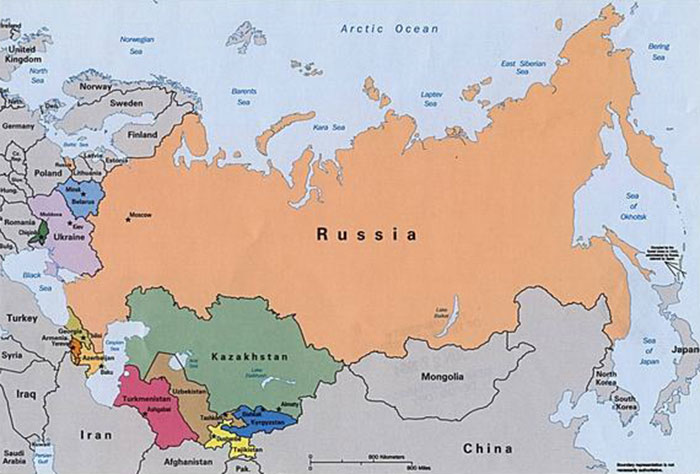Something Happened on the Way to the Market: The Economic State of the Former USSR
When it comes to the Soviet successor nations, economic and commercial diplomacy is a particularly important part of the U.S. foreign policy playbook.
BY MICHAEL A. LALLY

Commonwealth of Independent States, 1994.
CIA
After a decade-plus focus on counterterrorism and the Middle East, U.S. and European policymakers have begun to pivot attention back to Russia and Eurasia, where the rise of Russian autocratic nationalism and Moscow’s aggression in Ukraine have caused jitters from the Baltics to Central Asia. As the Kremlin looks to project power and influence, political and military considerations will continue to dominate policymaker bandwidth on Russia and Eurasia. However, the United States should make increasing use of one of the sharpest instruments in its policy toolbox: the strength of our economic system.
While Soviet successor states have achieved varying levels of economic independence in the past quarter-century, many have, more or less, repudiated the central planning of the past, and look instead to a free market model. For example, Ukraine’s 2014 Maidan demonstrations were triggered by former President Viktor Yanukovych’s decision to walk away from an Association Agreement with the European Union that would have deepened trade and investment ties.
In their protest, Ukrainians stood not for a free trade area per se, but for a European future with political pluralism, jobs and opportunity. The Baltic countries, with a strong national memory of independence, seized on economic reform and E.U. and NATO memberships to build competitive economies. Almost all other post-Soviet nations seek stronger economic ties with the United States, Europe and, increasingly, China.
This presents both opportunities and challenges for U.S. policymakers, who should further integrate economic and commercial diplomacy into the policy playbook.
Russia: One Step Forward, Two Steps Back
At independence in 1991, Russia was well positioned given its geography spanning two continents, its natural resources and its well-educated workforce. However, a bungled economic reform effort in the 1990s, combined with catastrophic drops in GDP, largely discredited free market principles. As one observer noted about the economic “shock therapy” of the 1990s, “It’s all shock and no therapy.” Market economics, freedom of the press and freedom of speech became code words for Western depravity, against which Mother Russia would protect its citizens. This lack of political and economic development spawned the rise of Putinism, permeating all levels of society.
During his tenure as president from 2008 to 2012, Dmitry Medvedev understood the challenge: the urgent need to modernize, with a focus on the economy. The United States supported Moscow’s efforts at global economic integration, using significant political capital to help secure Russia’s accession to the WTO, cancel the outdated Jackson-Vanik Amendment and encourage bilateral economic cooperation, in a strategic effort to give Russia a stake in the global economy and inoculate it against its historical xenophobic tendencies. But every transaction needs a buyer and a seller; and as Russia turned increasingly inward, Moscow was not buying.
The Khodorkovsky Affair of 2003 was later recognized as the defining case study of Putinist Russia, which can be summarized as “oligarchs, you can make and keep your money, but don’t even think about getting into politics.”
The Russian economy of today bears striking similarities to the 1980s: low oil prices reduce hard currency inflows; large state investments in industry bring little real return; Western sanctions followed by counter-sanctions on U.S. and E.U. agricultural products produce more domestic inflation; sanctioned Russian banks are unable to roll over significant dollar and euro debt—the list goes on.
Even more troubling is the increasing emigration of Russia’s best minds, drawn to economic opportunity in the West. Russia’s darkening political landscape and lack of innovation do not bode well for its economic outlook. Still, its considerable resources—human, natural and scientific—will help if, someday, Russia decides to seriously refocus on the economy.
Ukraine: A Test Case for Large-Scale Economic Reform in Eurasia
At the dawn of independence in 1991, many observers believed Ukraine had the best chance of success among all non-Russian former republics. Its proximity to European markets, developed rail system and ports, agricultural bounty, and educated workforce made Ukraine a smart bet. However, a combination of weak state institutions and a corrupt political elite led to a semi-functioning state at best. Case in point: in 1991, Polish and Ukrainian GDP were roughly equal. Today, the Ukrainian economy is about one-third the size of its western neighbor, now an E.U. member.
After more than two decades of kleptocracy on a massive scale, in November 2013 the Ukrainian people said “enough.” While fighting Russian aggression in the East and economic losses due to Russia’s illegal occupation of Crimea, in 2014-2015 Kyiv launched a battle against corruption and cronyism, leading to a courageous decision to implement painful but necessary economic reforms. With significant U.S. and European support, Ukraine has made major strides, achieving improved corporate governance, reduced dependence on Russian gas, accession to the World Trade Organization Agreement on Government Procurement, a public declaration of assets of government officials and the establishment of a new police force. The country has arguably made more progress on economic reform in the past two years than during the previous 25, but remains a critical test case for reforming a dysfunctional economy and developing strong, transparent institutions in a more or less free market economy.
The Caucasus, Moldova and Belarus: A Mixed Picture
In the 1990s, Azerbaijan’s significant hydrocarbon resources and smart energy transportation policy development gave the country an economic boost. U.S. support for the East-West energy corridor provided political space and real dollar returns, tripling Azeri per capita GDP by 2011. Boxed in by a frozen conflict in Nagorno-Karabakh and powerful neighbors in Iran and Russia, the late President Heydar Aliyev masterfully played a weak hand, leveraging the country’s oil and gas resources to secure independence. But predictably, “Dutch disease” set in, with petrodollars and corruption crowding out real economic development. Faced with a devalued Azeri manat, a rising cost of living and domestic unrest, the Baku elite took initial steps at economic reform. Increased use of e-government and tax reform measures have sought to reduce corruption, but much remains to be done. Continued low oil prices can provide an impetus to pursue broader economic reform, but the deep-rooted interests of powerful elites must be overcome to truly open up the Azeri economy.
Georgia has remained resilient despite endemic corruption dating to the Soviet period, a civil war in the 1990s and a brief but costly conflict with Russia in 2008. Despite a small economy and domestic market, Georgia pursued economic reforms for a simple reason: it had no choice. Georgia seeks stronger ties with Europe, as seen in its 2014 Association Agreement with the European Union. And it has improved its World Bank Ease of Doing Business ranking to 24—ahead of the Netherlands and Switzerland. Georgia’s recent elections received generally good reviews, a positive point for potential foreign investors. The country has proven to be a stable and reliable partner in the East-West energy corridor in exchange for needed revenue and a strong political anchor through direct investment by international oil companies.
Armenia and Moldova remain trapped in a geopolitical corner that has limited their economic development. In Armenia, Nagorno- Karabakh and strong Russian influence in the economy have closed off most options for diversification. In Moldova, the recalcitrant, so-called Trans-Dniester Republic and ongoing domestic political turmoil have limited reform in what is one of the poorest countries in Europe. These countries have small domestic markets and need to capitalize on their strengths in information and communication technologies, food processing and spirits.
Recognizing the challenge presented by its eastern neighbor, Belarus recently reactivated its long-dormant economic diplomacy to reconnect with international financial institutions. But the state remains the primary economic actor. Without dedicated economic reform, Belarus is unlikely to make significant progress.
Central Asia: Kazakhstan in the Lead, But…
Twenty-five years after independence, economic policy varies widely across the five countries of Central Asia. Their intraregional trade is among the lowest in the world, primarily because of poor infrastructure, a large grey economy and a lack of customs cooperation. Despite these challenges, Beijing has elaborated a comprehensive and well-funded “One Belt, One Road” concept that aims to use Central Asia as a land bridge into European and Middle East markets. The region’s longer-term challenge: to add value to the supply chain and not simply become a “drive through” for Asian exports to the West.
Kazakhstan has emerged as the undisputed regional leader in economic reform, building on significant petroleum wealth, smart energy transportation decisions and an imperfect, but more or less favorable, approach to private enterprise. Through constant rotation of senior government officials, President Nazarbayev has developed a bureaucratic elite with the knowledge, skills and experience to run the country. The country has suffered from low oil, gas and commodity prices that put downward pressure on the tenge, increased the cost of living and provoked sporadic protests. Astana has pursued longer-term economic competitiveness by joining the World Trade Organization and engaging in dialogue with the international business community.
Uzbekistan can potentially punch well above its weight in the region, given its significant territory, population, energy and mineral reserves, and developed heavy and light industry. However, Tashkent’s state-run economic planning model has spurred a large underground economy and multiple foreign exchange rates. Uzbekistan denies any problem with the availability of foreign exchange, but that is the number-one concern for Uzbek and foreign companies.
The Central Asian countries’ longer-term challenge: to add value to the supply chain and not simply become a “drive through” for Asian exports to the West.
Rather than deregulating its market to attract broad-based domestic and foreign investment, Tashkent has pursued an industrial policy based on high-tech industries. This has produced some limited success in export-oriented manufacturing. Still, with a loosening of economic decision-making and a reduction of the state’s role in the economy, Uzbekistan’s low costs and abundant labor could drive development. Late 2016 elections present an opportunity for both political and economic reforms that can unlock Uzbekistan’s potential.
Kyrgyzstan, Tajikistan and Turkmenistan have limited nearterm opportunities for broad-based economic development. Kyrgyzstan’s small market, lack of export-oriented production and limited, large-scale agricultural potential constrain its growth. Its mining sector, originally thought to present major opportunities for foreign investment, remains moribund. Tajikistan remains largely dependent on remittances from Russia. Given radical Islamist activity in the region, this presents near- and long-term challenges to U.S., Russian and European security. Turkmenistan remains largely closed to the outside world, striving for economic self-sufficiency. This undermines development of its huge gas reserves, which will remain largely unexplored absent an increase in global gas prices and a more competitive exploration and production environment.
Secretary of State John Kerry’s February 2016 marathon tour and August U.S.-Central Asia (C5 Plus One) engagement with the region’s foreign ministers are precisely the right kind of steps to engage the political, economic and human dimensions of our bilateral relationships in Central Asia. Given our crosscutting political, economic, security, intelligence and human rights interests in this region, the United States should simultaneously build all these pillars without waiting for resolution of one or another dimension.
The Baltics: The West’s Eastern Edge
At independence, the Baltic states emerged with relatively strong institutions, a constructive nationalist ethos and smaller, more reformable economies. In 2011, Estonia became the first post-Soviet state to adopt the euro and has the E.U.’s lowest debtto- GDP ratio. Latvia faced a severe economic shock following the 2008 global economic crisis, but began reforms to bolster the judiciary, reduce corruption and return to growth by 2010. Lithuania is investing in its own energy independence with the construction of the region’s largest liquefied natural gas terminal, which will reduce Russian gas supply leverage.
But the real picture in the Baltics is not in the country-by-country comparison, but in the aggregate: as a bloc, they represent the eastern edge of E.U., NATO and the rule of law. Given their large Russian populations and, in some places, a land border with Russia marked with sticks and poles, the Baltics look for continued support from Brussels and Washington. The recent Brexit decision did not go over well in Baltic capitals, which desperately need a united Europe and look nervously east. Fortunately, their E.U. and NATO memberships provide a solid economic and security foundation that international investors appreciate.
The Ties That Blind: A Eurasian Economic (Dis)Union?
Many Eurasian capitals were wary when Russia began advocating a Eurasian Economic Union in 2014. The proposal was viewed as a potential bridge for greater Moscow dominance in the region, with some arguing that the EAEU could be a back-door method of reconstituting the former Soviet Union. A closer look, however, quickly disproves this notion.
First, with few exceptions, Eurasian leaders do not see Moscow as the “shining city on the hill” for future political and economic development. Second, Eurasian elites are unlikely to want to cede authority to a Russian-dominated institution. Finally, “policy creep” is a major concern: a customs union with synchronized standards can lead to eventual calls for monetary union and a resultant loss of economic sovereignty.
Those Eurasian nations with sufficient political and economic wherewithal will play the long game on the EAEU; others, such as Uzbekistan and Ukraine, have rejected it out of hand. From a U.S. policy perspective, we should recognize that absent viable alternatives, some Eurasian nations will feel the need to cooperate at a minimal level with the EAEU. For example, Moscow holds the cards on work permits for millions of Central Asian migrants doing menial labor in Russia who send survival remittances back home. While Russia, and increasingly China, will play a key role in Eurasian economies well into the next decade, a more vigorous and strategic U.S. economic engagement in selected non-Russian states can provide some basic alternatives to policymakers in these capitals.
Looking Ahead to 2017: U.S. Policy Options
The 115th Congress and the next administration will have piles of briefing books on their desks during their first days in office. ISIS, Syria, China, India, global pandemics and climate change will all compete for the limited time and attention of senior policymakers. However, Russia’s continued recalcitrance, Ukraine’s stability, the Baltics as a NATO outpost and succession concerns in Central Asia should all focus policymaker attention on Eurasia, which is vital to U.S. interests. Moreover, policymakers should look at the region as a whole, not broken into artificial bureaucratic boundaries.
Make friends and influence people. Leadership succession decisions loom throughout the region, and U.S. policymakers should be prepared. This will require deep knowledge of competing political parties and clans, their business interests, and the views of weak and fractured civil societies. Repeat FSO assignments, investment in true area expertise and language competency in the Eurasia region should be encouraged to form lasting networks as mid-level decision-makers mature into the countries’ elites.
Silos don’t work. Full integration of U.S. hard and soft power, including political, economic, security, law enforcement, intelligence, assistance and public diplomacy components, is essential. Too often, disagreement on one dimension of our relationship with a Eurasian state produces a lockdown in other areas. U.S. policymakers should engage across platforms simultaneously to produce results in areas not directly related to a specific engagement.
It’s the economy, stupid. It’s a stock phrase in Eurasian capitals: “We want more American trade and investment.” While the livefire business environments of Eurasia make that an ambitious goal, more can be done to project American economic power. A revitalized Trade and Development Agency focus in Eurasia, further Overseas Private Investment Corporation investment and a fully functioning Export-Import Bank of the United States authorized to work in Ukraine could go a long way toward stitching together broken infrastructure, reducing energy losses and supporting American exports and business partnerships. USAID’s Development Credit Authority has been used to spawn economic activity at the grassroots level and should be expanded. This will require a strategic, integrated look by the next administration to ensure full deployment of our commercial diplomatic assets.
Mind the gap. Since the 1990s, graduate study in Eurasian affairs at U.S. universities has dropped significantly due to a focus on China and the Middle East and a decline in federal government and academic support for a new generation of Eurasia specialists. This is a luxury we cannot afford. Increased funding for scholarships, in-country language training, fast-track intake programs into the federal government and student loan forgiveness incentives should be simplified and revitalized.
Past as Prologue?
For the past 25 years, Eurasian governments have taken a cautious approach to political-economic development: private enterprise will be tolerated as long as it strengthens the state and does not threaten elite interests. That might have worked in the pre-internet, non-globalized world into which the Soviet successor states were born, but it gets more difficult with every passing technological innovation.
How a government treats private enterprise is almost always a reflection of its attitude toward its own citizens. A state that can foster an innovative, entrepreneurial society, where citizens can safely turn an idea into a business, shows a government at peace with itself and the presence of a respected social contract. Governments that restrict the private sector out of fear of creating competitive institutions treat their own people with wariness and contempt.
While Ukraine is struggling to become a more democratic, free market-oriented country, Russia, Belarus, Turkmenistan and other Eurasian states still long for the glory days of a strong central government. During my years in Eurasia, many of my counterparts and friends voiced the desire to become a “normal country.” Some Eurasian states have embarked on this path, trying to create an economy and society that can grow in the 21st century. Others have not. As the Eurasian states enter full adulthood, it is in our national security interest to ensure their success.








